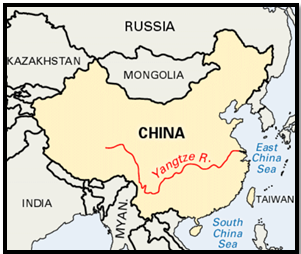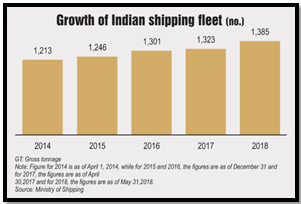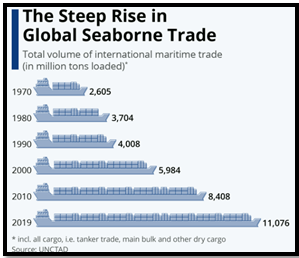INDIA’S STATIONARY COURSE IN THE SHIPPING VALUE CHAIN
Syllabus
- GS2: Infrastructure: Energy, Ports, Roads, Airports, Railways etc.
Why in the News?
- India’s maritime industry, once a beacon of promise, faces challenges and missed opportunities.
- Unlike China, which elevated its shipping sector, India’s shipbuilding and ownership lag.
Source: Britannica.com
Yangtze River: China’s Timeless Lifeline
Embracing Tradition and Modernity
- The Yangtze River, etched in China’s history, resonates with tradition, myth, and cultural richness.
- Today, it’s not just a relic of the past but a vital lifeline for modern China, seamlessly blending antiquity and contemporary vitality.
3 Gorges Project Impact
- The grand 3 Gorges project, a modern marvel, has further elevated the Yangtze’s significance.
- It’s akin to hearing ancient opera violins while witnessing colossal merchant ships gracefully navigate the river’s waters.
Commerce and Culture Coalesce
- Shipping Dynamics: Imagining the river’s melodies, one witnesses a bustling scene with massive merchant ships navigating the waters, symbolizing China’s vibrant commerce.
Yangtze River: Maritime Symphony
A River Unlike Others
- The Yangtze River offers a spectacle unlike the Suez or Panama canals.
- Instead of ships forming a single line, here you witness multiple convoys sailing side by side.
Spectacle of Skill
- For ship enthusiasts, it’s a stunning show of skill—captains showcasing seamanship, planners orchestrating logistics, and pilots guiding these vessels like maestros conducting a symphony on the water.
Yangtze River: China’s Economic Engine
Global Trading Hub
- Ships on the Yangtze River play a crucial role in China’s global trade.
- They bring raw materials from places like Peru and Africa to Chinese-owned mines and carry finished products worldwide.
- The river hosts both new ships, constructed in shipyards at every turn, and older ones getting repairs in the same docks.
China’s Success Tale
- The Yangtze represents the classic “look how China surged ahead” story.
- By comparing China’s growth with India’s, especially post-1980s, this story, often backed by stats, illustrates China’s remarkable economic leap, leaving India in its wake.
India’s Maritime Legacy
1980s Era
- Back in the late 1980s, India was ahead in the ship race.
- While China was just beginning to make waves in global shipping, India was already in the game, sailing confidently.
Rich Maritime Tradition
- India had a strong tradition of ship-owning.
- A remarkable example was an ex-Indian Navy officer who owned massive oil tankers—still the largest ever built.
- India’s maritime prowess extended to close ties with the International Maritime Organization.
Unique Contributions
- India’s early initiatives and remarkable individuals shaped a maritime legacy that often goes untold, contributing significantly to the global shipping narrative.
Indian Shipyards: A New Horizon
Private Players Rise
- Private players entered an arena traditionally dominated by large public sector facilities, signaling a shift.
- Indian shipyards started showing promise in building ships that could compete globally.
Labour Advantage
- Even before the IT sector, India leveraged labor arbitrage in shipping.
- English-proficient Indian seafarers became common globally.
- Shipping, prioritizing safety, preferred English-speaking crews, marking a shift from hiring eastern Europeans with language limitations.
Source: Indianinfrastructure.com
Seafaring Growth in India
Government Focus
- Successive governments prioritized labor supply for growth and foreign exchange earnings.
- Similar to other sectors, labor export became a key aspect of India’s economic strategy.
Decentralization and Expansion
- Under the United Progressive Alliance (UPA) government, maritime training decentralization occurred, opening the field to private players.
- This led to a proliferation of institutions across India, producing seafarers with diverse skills.
Global Presence
- Today, Indian seafarers are ubiquitous on ships worldwide, ranging from Arctic-class vessels to ore carriers in Chilean ports.
- Out of every 20 seafarers on a ship, it’s likely that four or five are Indian.
Beyond Sailing: India’s Ship Management Prowess
Diversification into Ship Management
- Indian talent for value engineering extended into ship management.
- Indians, adept at running a tight ship, have taken charge of ship operations efficiently.
- Numerous ship management companies have emerged, overseeing fleets of hundreds of ships.
Financial Contribution
- Sanjay Prashar estimates that Indian seafarers and their management companies contribute a significant $6 billion in foreign exchange annually.
- This financial inflow showcases India’s prowess in the global maritime industry.
Comparative Remittances
- To put it in perspective, India’s total foreign remittances amount to around $125 billion, while China’s stand at $50 billion, indicating the substantial contribution of the Indian maritime sector to the economy.
India’s Shipping Challenges
Barriers to Full Maritime Participation
- While excelling in seafaring and ship management, Indians face obstacles in ship owning, chartering, financing, and building.
- These segments largely elude Indian involvement, limiting the nation’s maritime growth.
Impact of Government Policies
- India’s state-owned Shipping Corporation has faced challenges, affecting the order book of Indian shipyards.
- Private shipowners often opt for second-hand ships due to cost advantages and alignment with short-term market predictions.
Contrasting Chinese Success
- In contrast, China, fueled by a strategic government plan, became a global shipbuilding powerhouse by 2020, producing half of the world’s ships.
- Chinese shipowners predominantly constructed their vessels in state-owned yards, reminiscent of the practices in Japan and Korea.
Source: Statista
India’s Shipbuilding Struggle: Unfulfilled Ambitions
Missed Targets
- The UPA government’s Maritime Agenda 2020 aimed to elevate India’s global shipbuilding share from under 2% to 5%, but by 2020, India’s presence in global shipbuilding had nearly vanished.
Vision Gaps
- The BJP government’s Maritime India Vision 2030 highlights logistics, the environment, port infrastructure, and seafarer growth but lacks any mention of shipbuilding plans.
- Despite initiatives like Sagarmala, naval ship orders dominate, leaving commercial shipbuilding aspirations unaddressed.
Strategic Importance of Shipbuilding for India
Untapped Potential Despite Strategic Location
- Despite its long coastline and strategic geographic position, India has failed to leverage shipbuilding as a crucial element to boost manufacturing and enhance strategic influence.
Global Presence through Shipbuilding
- Active participation in shipbuilding and ownership would not only secure India’s position in the global maritime industry but also elevate its standing in international trade.
Military Might and Shipbuilding Nexus
- Shipbuilding is not just about commerce; it forms a critical aspect of naval strength.
- The destruction of Nagasaki, a key naval shipyard during World War II, highlighted the military significance of shipbuilding in securing naval dominance.
| Yangtze River
· Origin : The Yangtze River, known as the “Long River,” originates in the Tanggula Mountains on the Tibetan Plateau, specifically in Qinghai Province, China. · Spanning 6,300 kilometers (3,915 miles), the Yangtze gracefully winds its way through 11 provinces and municipalities in China. · The river concludes its journey by flowing into the East China Sea near Shanghai, forming a vast and fertile delta. |
Source : Hindu
Mains Practice Question
Q. Examine the historical trajectory of India and China in the global shipping industry. How did India, once ahead, fall behind, and what factors contributed to China’s dominance?

 Source: Britannica.com
Source: Britannica.com Source: Indianinfrastructure.com
Source: Indianinfrastructure.com Source: Statista
Source: Statista

